Sports Bar Multiple TV Setup
Our 15 years of sports bar system design experience at Crunchy Tech has shown us that right TV setup and installation can determine a sports bar’s success.
This online resource helps you choose and understand TV placement and setup while explaining essential system requirements and how to protect your investment.
Sections:
Indoor TV Display Fundamentals for Sports Bars
Commercial vs Consumer TV Displays: Critical Differences
Professional sports bars require commercial digital displays that work without problems during their long daily operating hours. The right TV’s deliver better light output and faster response times plus they should have advanced settings needed for sports viewing spaces.
The following table shows important distinctions between display types to help you understand why commercial displays are worth the investment.
| Feature | Commercial Grade | Consumer Grade |
|---|---|---|
| Daily Operation | 16-24 hours | 4-8 hours |
| Warranty | 3-5 years commercial | 1 year residential |
| Brightness | 500-700 nits | 250-350 nits |
| Input Lag | < 8ms | 15-30ms |
| Heat Management | Advanced cooling systems | Basic heat dissipation |
| RS232/IP Control | Yes | Limited/None |
| Cost (55″) | $1,200-2,500 | $500-1,200 |
Optimal TV Screen Size and Viewing Distance
Selecting appropriate screen size and location determines how well viewers will experience content. Using a 2.5:1 ratio standard helps us find the best viewing distance for displays of any size.
This chart shows typical display sizes used in sports bar setups.
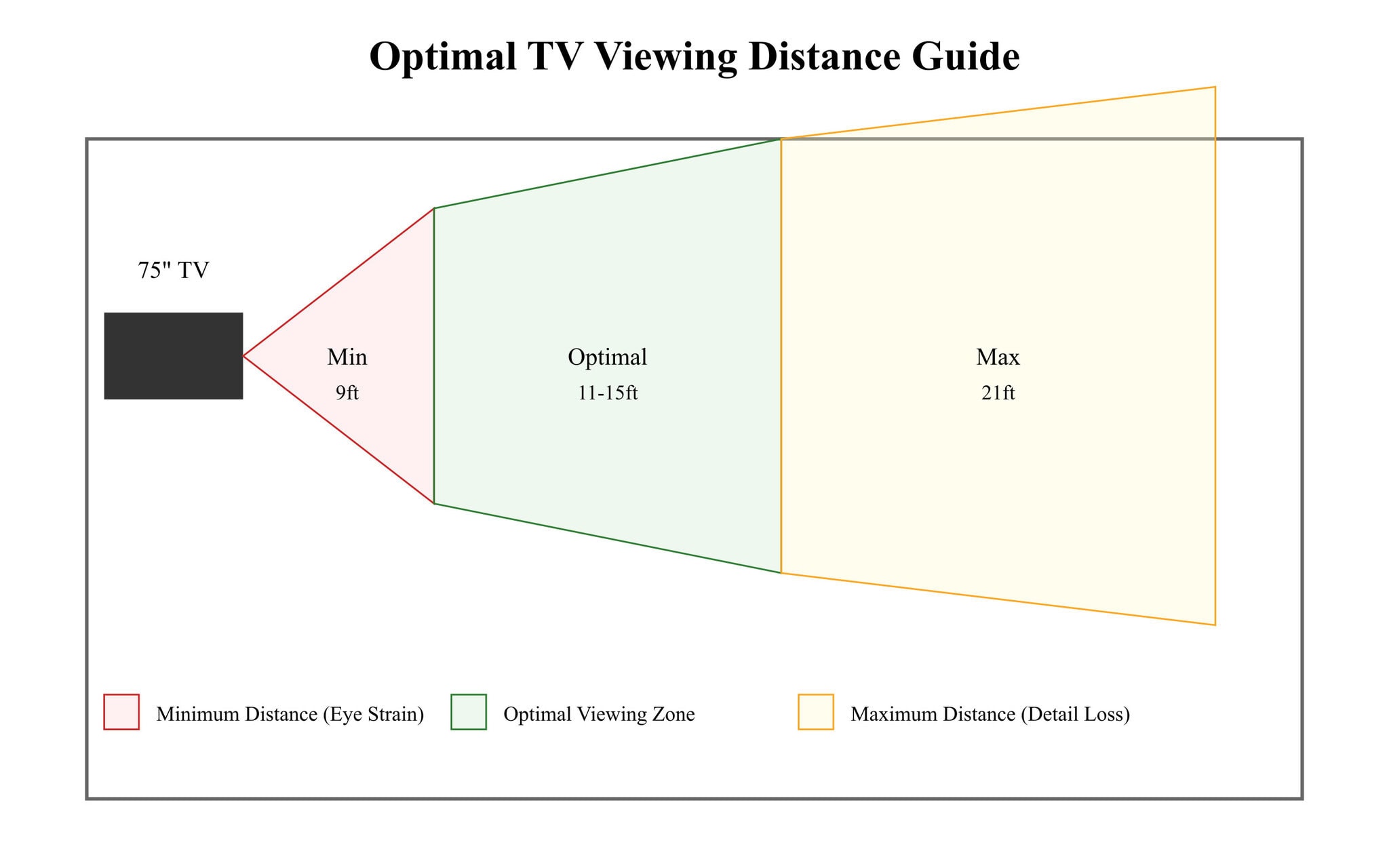
You should sit between 11-15 feet away from a 75″ display to see it best while keeping your eyes comfortable and allowing you to move your head freely.
Stay at least 8 feet away to avoid eye strain.
Quick Reference Formula
- Minimum Viewing Distance = Screen Diagonal × 1.5
- Maximum Viewing Distance = Screen Diagonal × 5
- Optimal Viewing Distance = Screen Diagonal × 2.5
Optimal Viewing Distance Chart
| Screen Size | Minimum Distance | Optimal Distance | Maximum Distance |
|---|---|---|---|
| 55″ | 7 feet | 8-11 feet | 15 feet |
| 65″ | 8 feet | 10-13 feet | 18 feet |
| 75″ | 9 feet | 11-15 feet | 21 feet |
| 85″ | 11 feet | 13-17 feet | 24 feet |
| 98″ | 12 feet | 14-19 feet | 27 feet |
TV Resolution Requirements for Sports Content
Modern broadcasting standards brought a marked evolution to resolution requirements for sports programming. 1080p represents the standard acceptable resolution yet 4K (2160p) programming is essential for top-tier sports competition broadcasts.
The necessity for higher resolution levels becomes especially important as display sizes expand to video walls where pixel density determines image clarity. 4K live sports broadcasts need network speeds between 15-25 Mbps which demands strong network infrastructure.
Leading sports networks deliver their broadcasts at either 1080i resolution up to 720p resolution beside which 4K broadcasting represents standard practice during top-tier events.
The right TV display system must accommodate present-day resolution standards in addition to upcoming technologies to maintain compatibility into the future.
Modern sports broadcasting demands specific resolution capabilities:
| Content Type | Minimum Resolution | Recommended Resolution | Bandwidth Required |
|---|---|---|---|
| Live Sports | 1080p | 4K (2160p) | 15-25 Mbps |
| ESPN/FS1 | 720p/1080i | 1080p | 8-12 Mbps |
| Streaming | 1080p | 4K HDR | 20-35 Mbps |
TV Display Technologies: LED, LCD, QLED Comparisons
Sports bars benefit from varying display technologies because each brings particular strengths to such setups. The comparison below shows performance differences which guide you to choose the right display technology according to your requirements and budget.
TV Display Technology Comparison
| Display Technology | Advantages | Disadvantages | Best Use Case | Typical Cost/sq ft |
|---|---|---|---|---|
| LED | • Highest brightness • Best viewing angles | • Highest cost • Complex installation | Main viewing areas Video walls | $150-$300 |
| LCD | • Lowest cost • Most Reliable • Wide availability | • Limited contrast • Narrower viewing angles | Secondary viewing Bar areas | $50-$100 |
| QLED | • Enhanced color • Good brightness • Better contrast | • Higher cost than LCD • Not as bright as LED | Primary viewing Mixed lighting areas | $100-$200 |
TV Glare Management and Ambient Light Considerations
The sports bar TV installation process involves both glare management and ambient light analysis. The installation of sports bar displays faces significant challenges when managing ambient light conditions.
Viewer comfort and display readability both depend heavily on both natural daylight and manufactured lighting systems. Display placement during professional installations needs careful evaluation of window and lighting fixture positions to maintain at least a 45° angle from direct light sources.
High-performance displays which feature anti-reflective coatings and more than 700 nit brightness address the problem of screen glare. Automated brightness control systems together with strategic window treatments maintain optimal viewing conditions during all daily periods. The way light is managed affects how long customers stay and their satisfaction with the display experience.
Ambient Light Management
| Environment | Required Brightness | Anti-Glare Solution |
|---|---|---|
| Direct Sunlight | 700+ nits | High-haze coating + sensor |
| Bright Indoor | 500-700 nits | Medium-haze coating |
| Standard Indoor | 350-500 nits | Standard coating |
| Dark Areas | 250-350 nits | Optional coating |
Strategic TV Setup and Placement
Viewing Angle Optimization
Optimal screen angles determine how successful your sports bar’s viewing experience will be. The industry standard suggests horizontal viewing angles should stay within 45° of center while the best range for clarity and color accuracy lies between 0-30°.
To maintain proper color representation and contrast levels screens must be positioned so vertical viewing angles do not exceed 30°. When TV sets are installed above eye level we suggest an angle between 5-15° tilted downward to help prevent neck stress while offering better screen watching comfort.
| Viewing Angle | Visibility Impact | Maximum Angle |
|---|---|---|
| Horizontal | Optimal: 0-30° | 45° |
| Vertical | Optimal: 0-15° | 30° |
| Screen Tilt | 5-15° downward | 20° |
Line-of-Sight Planning
When establishing proper line-of-sight planning all physical barriers and seating setups for patrons need attention. All rooms designed for viewing should maintain visibility of displays for both sitting and standing spectators.
Tables must maintain 48″ clear zones above them while bar counters require 24″ and structural elements need visibility clear zones that extend to 36″ radius for complete viewing access from every location.
Line-of-Sight Considerations
| Obstruction Type | Minimum Clearance | Solution |
|---|---|---|
| Tables/Booths | 48″ above surface | Elevated mounting |
| Bar Top | 24″ above counter | Angled mounting |
| Support Columns | 36″ radius | Multiple display zones |
Mounting Height Guidelines
The correct screen mounting height depends on both the different areas within a venue and the most common viewing position of the audience. The screen should be mounted at 57-65″ from the center for seated viewers in bar areas but requires 72-80″ center height for standing viewers.
The objective is to position screen centers about 15° above normal eye level to avoid neck strain during long viewing periods.
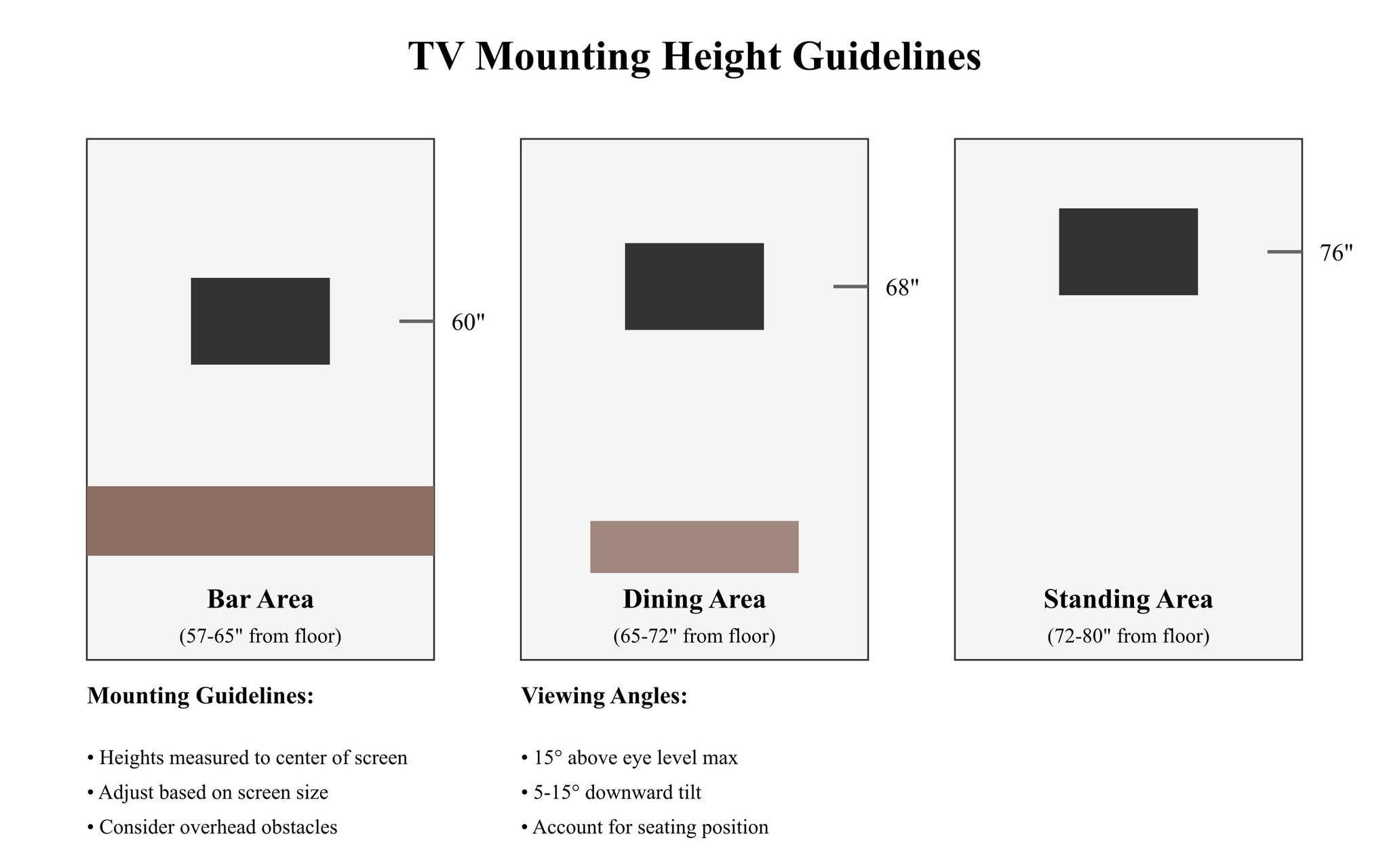
| Location | Height Range | Center of Screen |
|---|---|---|
| Bar Area | 57-65″ | 60″ from floor |
| Dining Area | 65-72″ | Eye level +15° |
| Standing Area | 72-80″ | 6′ viewer +10° |
TV Zone Creation for Different Sports/Events
Through strategic zone creation we can increase viewer options and control crowd movement. Your primary viewing area needs large displays or video walls to show major events whereas secondary viewing spaces should consist of numerous smaller screens which track different activities.
Different zones need individual audio solutions which range from main game audio zones to ambient sound control for dining spaces.
| Zone Type | Primary Content | Display Config | Audio Priority |
|---|---|---|---|
| Main View | Featured Games | Video Wall/Large Display | Primary Audio |
| Bar Zone | Multiple Games | Multiple Displays | Secondary Audio |
| Dining Zone | Mixed Content | Standard Displays | Low/Muted |
| Outdoor | Weather-Resistant | High-Bright Displays | Zoned Audio |
Video Wall Configurations
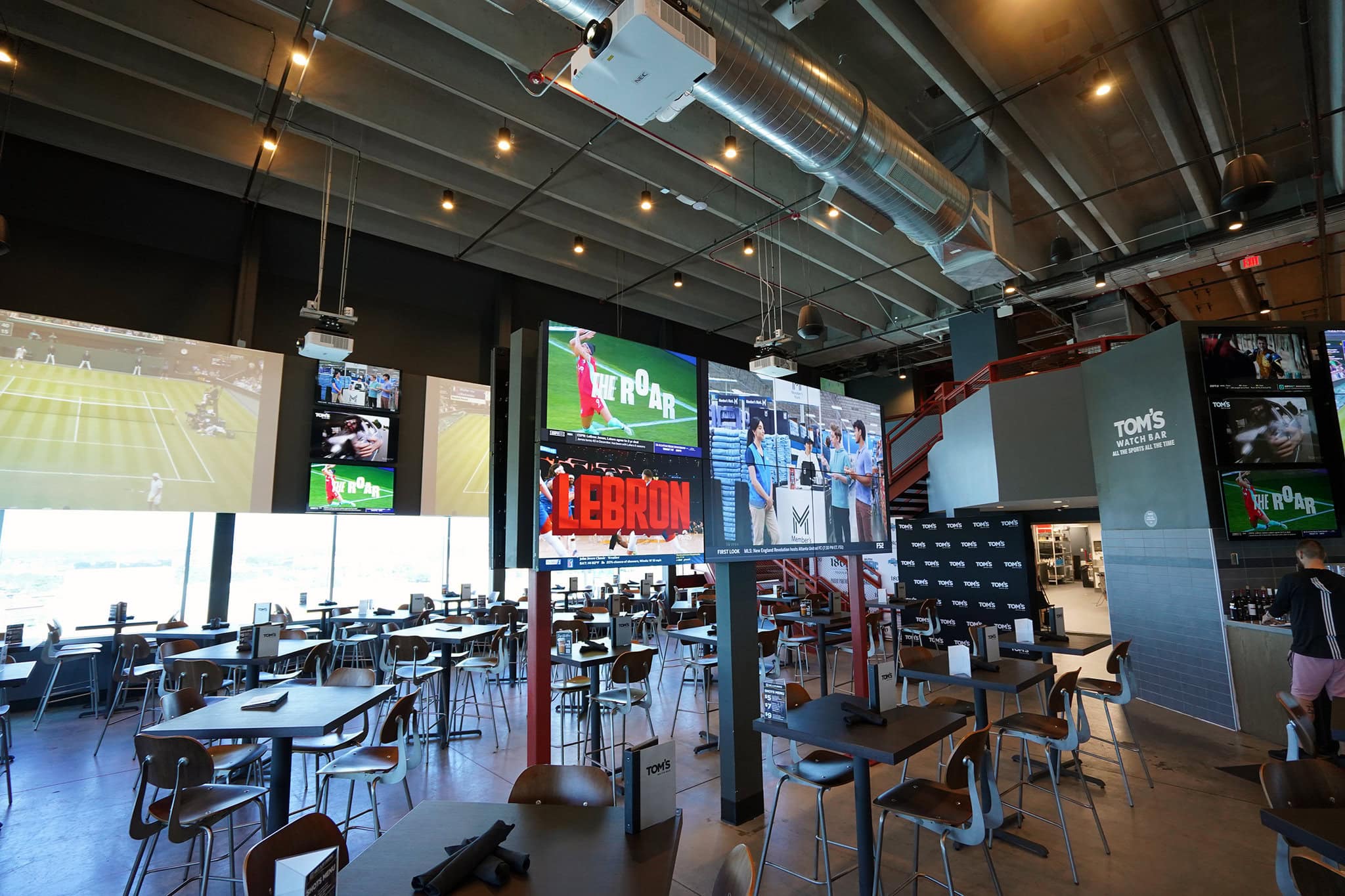
In modern sports bars video walls create central viewing experiences while they support various content display options.
Standard installations use 2×2 arrays while premium viewing areas require 3×3 arrays and bar areas benefit from 1×3 horizontal arrays.
The choice of video wall configuration depends on how far viewers will be from the screen and the lighting conditions of the space along with what content will be displayed.
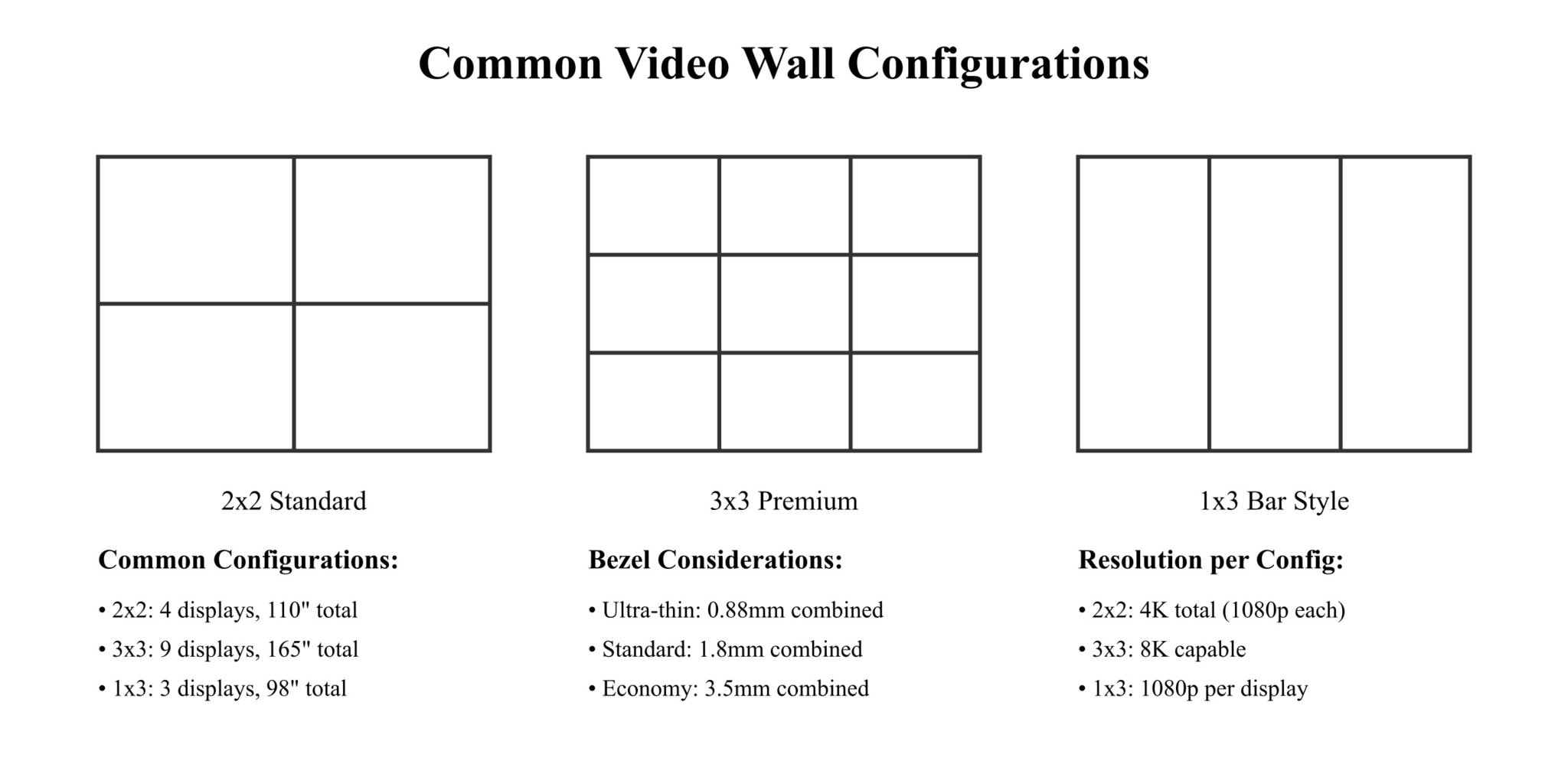
Outdoor TV Solutions
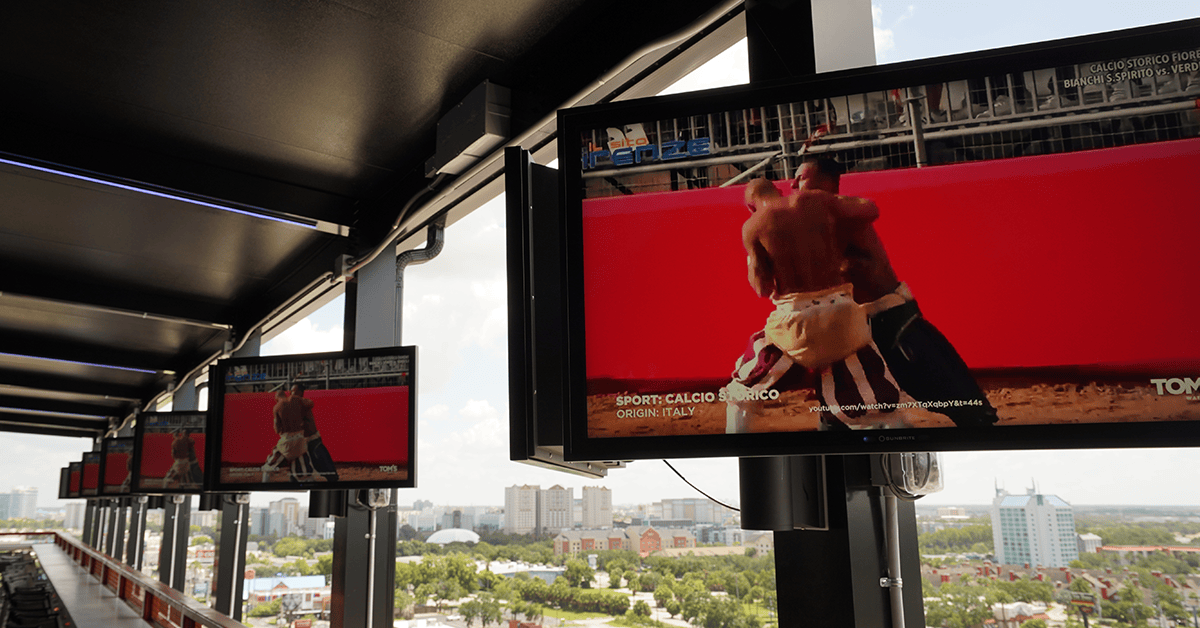
Weather-Rated TV Display Requirements
Outdoor commercial displays require more stringent standards than indoor display systems. The weather rating of a display defines its operational safety in outdoor environments through combined protection from various environmental threats.
The rating system evaluates protection against water exposure and dust infiltration while testing impact resistance and operational stability in extreme temperature conditions. The choice of proper rating requires careful consideration of the environmental challenges present at the installation location.
| Protection Rating | Minimum Requirement | Recommended |
|---|---|---|
| IP Rating | IP54 | IP65 or higher |
| Operating Temp | -20°F to 120°F | -30°F to 140°F |
| UV Protection | 3,000 hours | 6,000 hours |
| Impact Rating | IK08 | IK10 |
Outdoor TV Brightness and Visibility Factors
The visibility of outdoor displays encounters special difficulties because ambient light conditions change throughout the day. Standard displays become unreadable when direct sunlight hits them during peak sunlight hours.
Professional outdoor displays need brightness levels that are 2-3 times greater than indoor displays to remain visible under difficult daylight conditions.
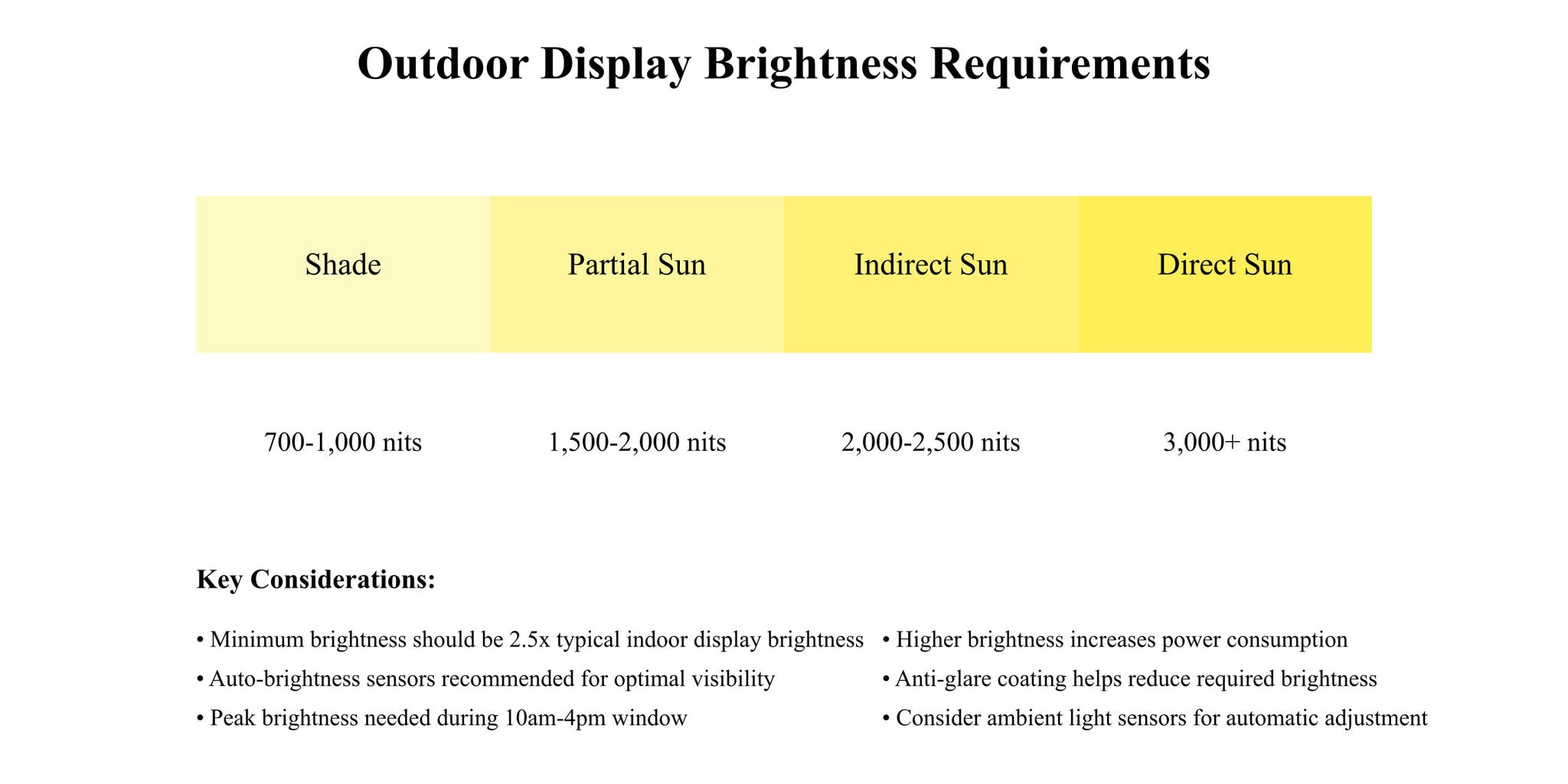
Temperature Management Systems
Outdoor display systems need effective temperature management to maintain their longevity. The systems need to manage extreme temperature ranges while keeping internal operating temperatures at their best.
Advanced cooling systems maintain performance stability in all weather conditions through multiple protection layers which include passive heat dissipation and active cooling solutions.
| Component | Function | Specifications |
|---|---|---|
| Cooling Fans | Active Ventilation | IP66 rated, 100 CFM min |
| Heat Exchangers | Temperature Control | 5,000 BTU capacity |
| Thermal Sensors | Monitoring | -40°F to 185°F range |
| Auto-Shutdown | Protection | Triggers at 140°F |
Sports Bar TV Display Infrastructure Requirements
Power Distribution Planning
The foundation of commercial AV installations depends on correct power distribution systems. Multiple dedicated circuits are necessary in sports bars to support high-draw equipment such as video walls and display clusters.
Critical components require clean power sources that maintain proper separation from noise-producing devices such as kitchen equipment. UPS systems protect sensitive equipment from power fluctuations because redundancy remains essential and backup generators deliver power during outages.
A typical sports bar AV system requires at least three dedicated 20A circuits: The system needs three separate 20A circuits which serve the equipment rack and video walls as well as distributed displays.
Heat Load Calculations
Heat management significantly impacts system reliability and longevity. Today’s audiovisual equipment produces massive amounts of heat so a standard rack of technological units emits 24,000 BTU/hr which necessitates active cooling methods.
Equipment-generated heat together with the outdoor ambient temperature and solar gain through windows are critical components to include in heat load calculations. An optimal operating temperature and avoidance of system breakdowns can be accomplished through proper ventilation which requires 100 CFM per every 1,000 BTU/hr of heat.
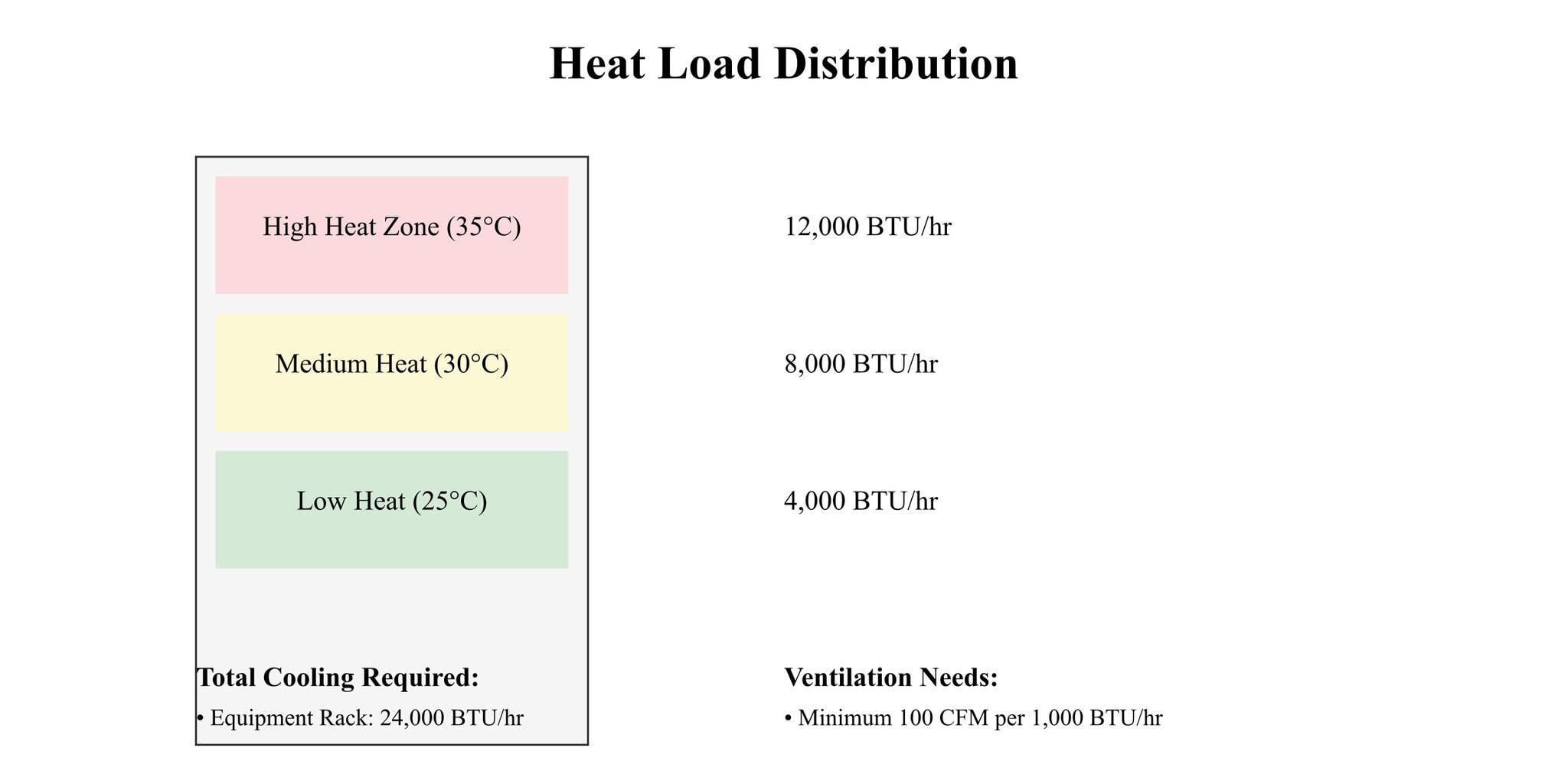
Cable Management Systems
System maintenance and troubleshooting depend on professional cable management which also enhances system aesthetics. Signal types need distinct pathways to avoid interference because power cables require separation from signal cables and fiber optic cables need protection against physical stress.
Support systems for cables need to include bend radius specifications particularly for HDMI and fiber optic cables. Documented and correctly labeled cable installations promote effective equipment upgrades and maintenance operations.
Network Infrastructure for Content Distribution
The performance of contemporary sports bar AV systems depends on strong network infrastructure. AV network design demands 10Gb backbone switches while connecting endpoints through 1Gb connections.
VLANs isolate Video Over IP traffic from business network activities through QoS mechanisms that stabilize video stream performance.
Network infrastructure needs to support simultaneous support for 4K video streams yet preserve minimal delay for live sporting events.
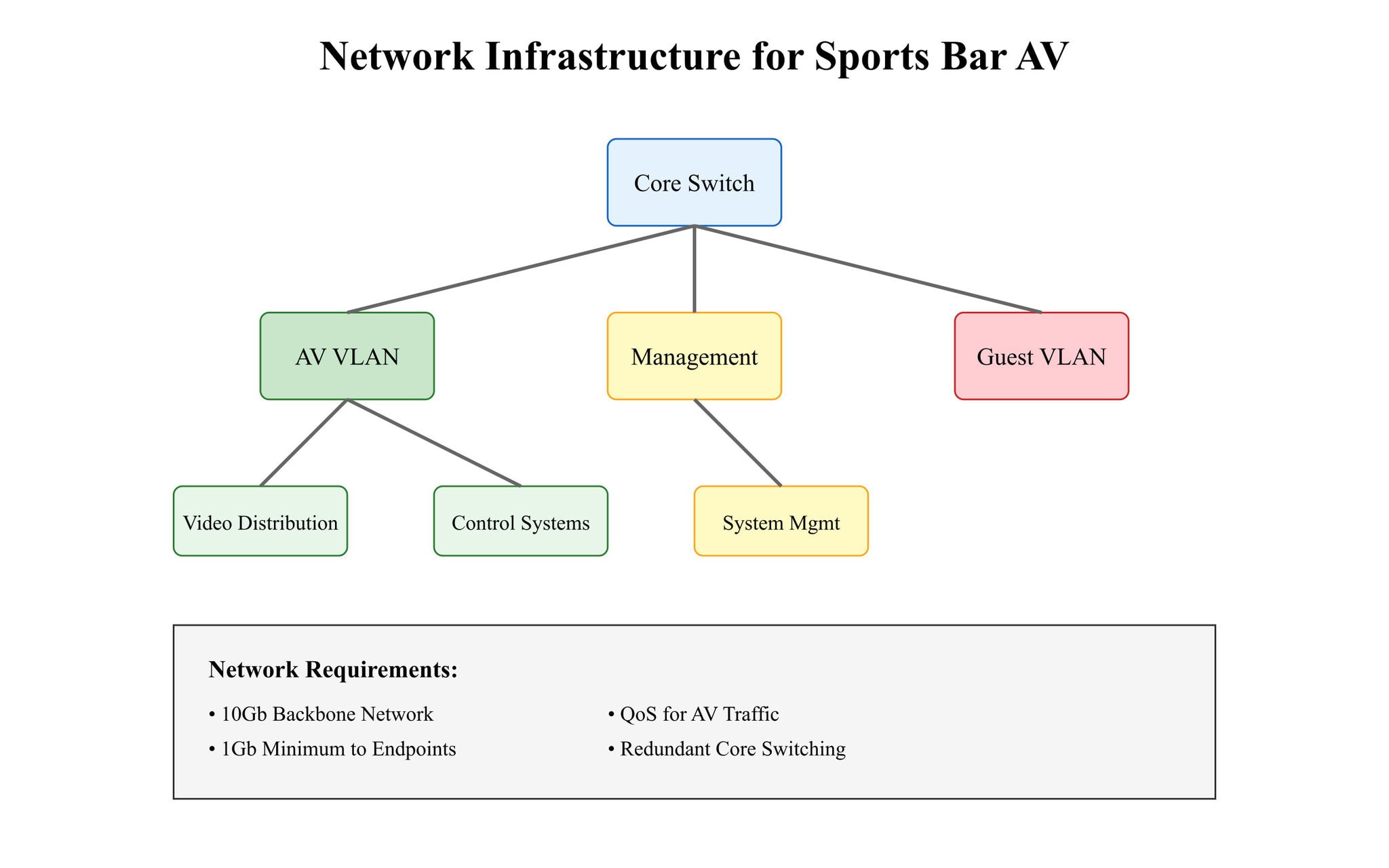
HDMI vs AV over IP Solutions
Selecting traditional HDMI matrix systems versus AV over IP solutions determines performance today while shaping future expansion possibilities. HDMI matrices deliver ultra-low latency with guaranteed bandwidth but their fixed I/O configurations and distance limitations create operational restrictions.
AV over IP solutions deliver enhanced scalability and flexibility yet demand precise network design to maintain performance levels. Sports bars today combine HDMI connections for main viewing areas with AV over IP technology for additional display screens.
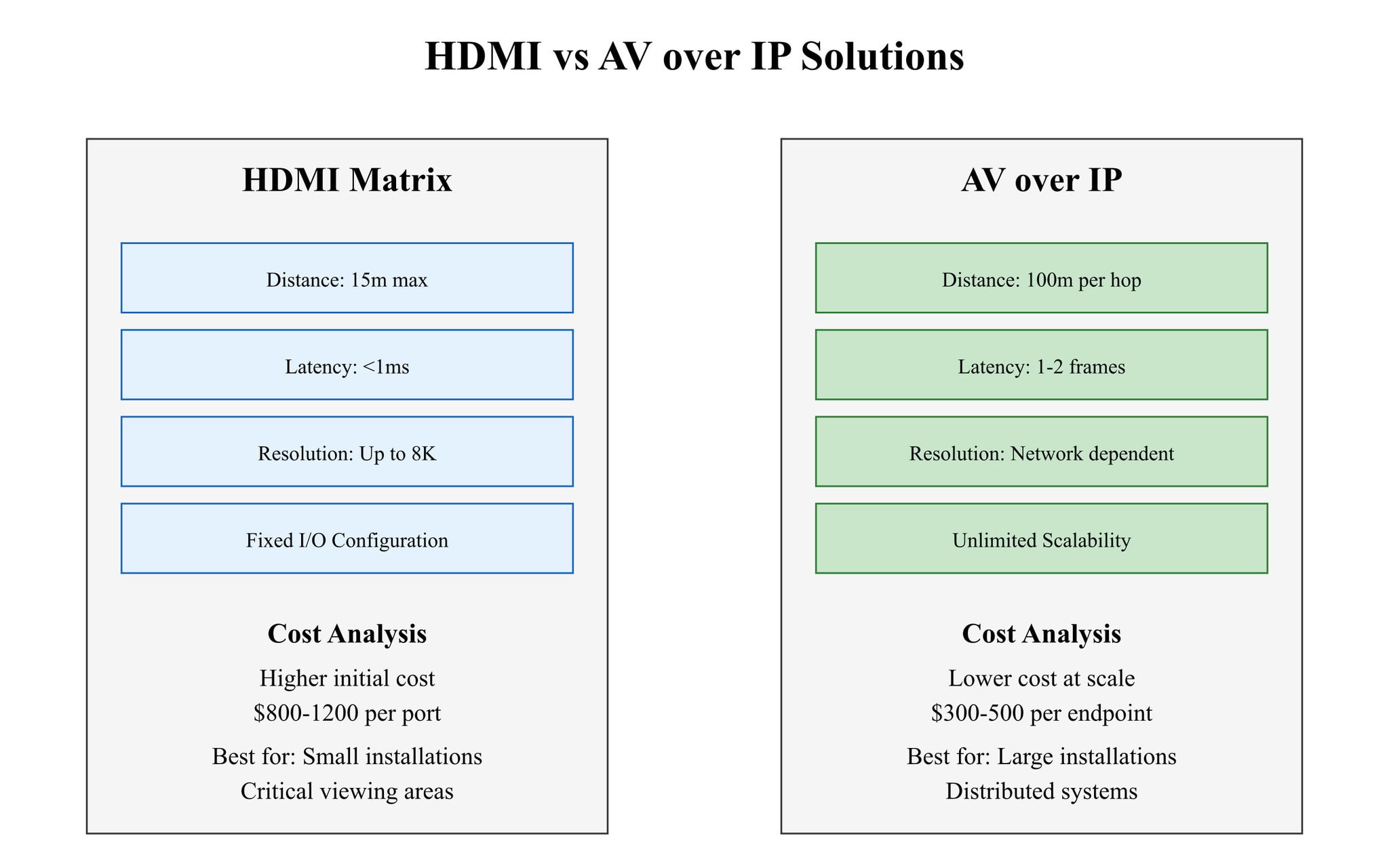
Sports Bar Content Management
Matrix Switching Systems
Modern sports bars depend on matrix switching systems to distribute their content. Matrix systems offer basic 4×4 setups through to enterprise solutions that manage 32 or more sources and displays. Advanced matrix systems deliver IP-based control and support high-resolution 4K and 8K setups while costing between $8,000 to $15,000 or more.
The selection of basic, advanced or network-based matrix systems should be based on venue size and scalability requirements because larger venues gain advantages from networked systems which remove traditional I/O constraints.
| Feature | Basic Matrix | Advanced Matrix | Network Matrix |
|---|---|---|---|
| Inputs | 4-8 | 16-32 | 32+ |
| Outputs | 4-8 | 16-32 | Unlimited |
| Resolution | 1080p/4K | 4K/8K | Network Dependent |
| Control | RS232/IR | IP/RS232 | IP Based |
| Cost | $2-$5K | $8-$15K | $15K+ |
Video Distribution Architecture
Video distribution architecture in sports bars requires a three-tier approach: The video distribution architecture operates through three main components which include source management followed by signal processing and display distribution.
The core processing system obtains input from devices such as satellite receivers and cable boxes as well as streaming devices to manage both format conversion and content routing.
The processed signals reach multiple display zones by using either HDMI matrices or AV-over-IP networks. The system architecture needs to preserve signal quality and support both flexible routing capabilities and redundancy features.
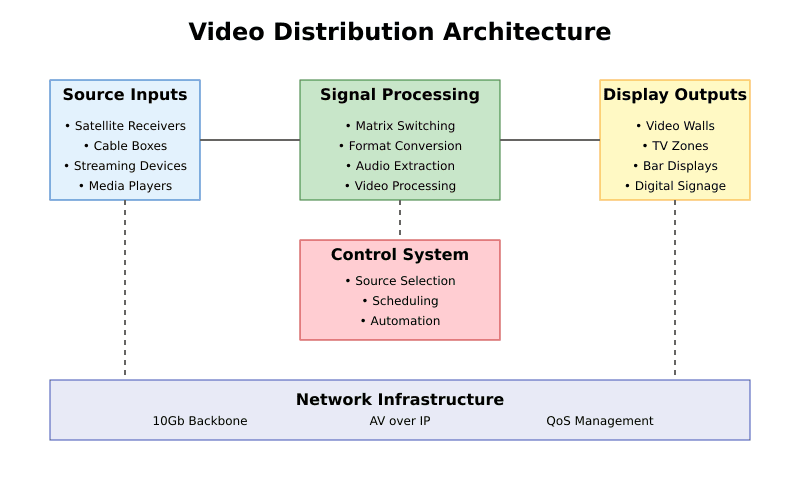
Multi-Source Management
Multi-source management provides solutions for the complex task of processing multiple content inputs at the same time. Each source type presents unique challenges:
Dedicated tuners and HDCP compliance serve satellite/cable functions while streaming devices operate best with stable network bandwidth through QoS prioritization and local media servers operate through efficient storage management.
Current systems need to process multiple input types while keeping display synchronization intact and optimizing bandwidth distribution throughout the network.
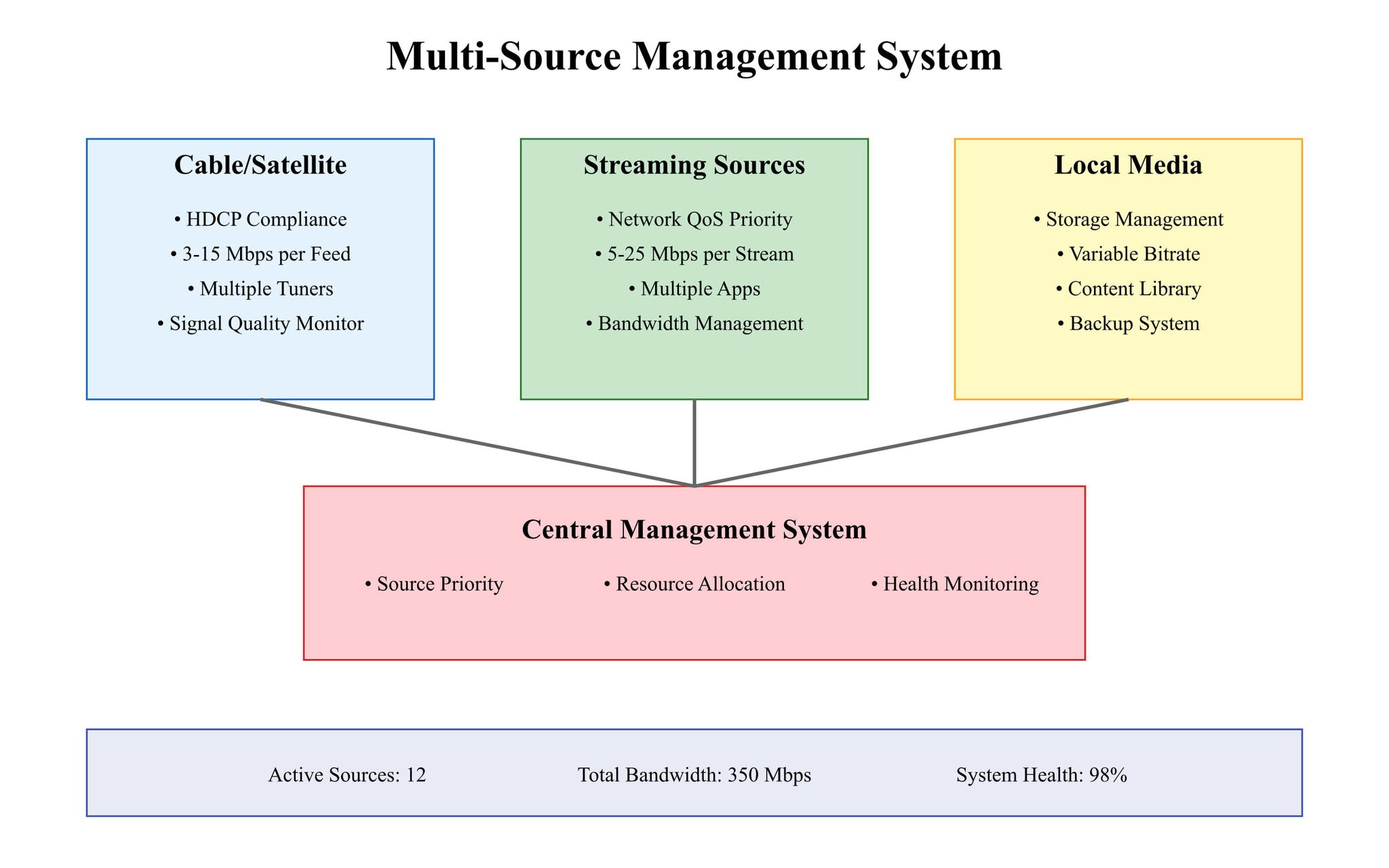
Content Scheduling Systems
When using content scheduling users gain automation support for managing many display activities across different parts of the day. These systems can connect to sports calendars to direct suitable content to specific areas while managing audio routing for priority events and enabling emergency overrides when necessary.
Advanced scheduling systems connect digital signage and POS systems to synchronize promotions and specials with scheduled events which results in a unified customer experience.
Content Scheduling Systems Solutions
| System | Base Price | Features | Best Application |
|---|---|---|---|
| Extron GlobalViewer | $2,500+ | • Event-based automation • Mobile control • Hardware integration • Custom GUI • Multi-location support | Large venues with multiple zones |
| Crestron Fusion | $3,000+ | • Cloud-based scheduling • Energy management • Remote monitoring • API integration • Analytics dashboard | Enterprise-level sports bars |
| Q-SYS Scheduler | $1,500+ | • Audio zone management • Touch panel interface • Network redundancy • Sports feed integration • Real-time monitoring | Mid-size venues |
| AMX RMS | $2,000+ | • Asset management • Maintenance alerts • Usage reporting • Mobile app control • Multiple user levels | Chain restaurants |
| RTI Control | $1,000+ | • Basic scheduling • Source management • Custom triggers • Email notifications • Remote access | Small venues |
| Control4 | $1,800+ | • Intuitive interface • Weather triggers • Voice control option • Mobile app • Scene creation | Luxury sports bars |
| ELAN | $2,200+ | • Drag-drop scheduling • Climate integration • POS integration • Custom rules • Audio distribution | Full-service restaurants |
| Savant Pro | $3,500+ | • Premium automation • Energy monitoring • Scene scheduling • Music streaming • Video tiling | High-end establishments |
Sports Bar Audio Integration Considerations
Choosing a Commercial Sound System For your Sports Bar
Sports bar commercial sound systems need precise component selection to achieve dependable performance and full coverage. Commercial sound systems start with 70V amplifiers from main manufacturers that provide power capacities in the range of 500W up to 2000W based on venue size enabling them to link directly to digital signal processors to manage audio zones and system controls.
The selection of professional speakers depends on their mounting location and coverage needs because ceiling-mounted speakers perform best in dining spaces while surface-mount speakers fit bar areas and patios. System design requires coverage between 70 and 85 dB consistently across the venue along with clear audio reproduction for both background music and game audio.
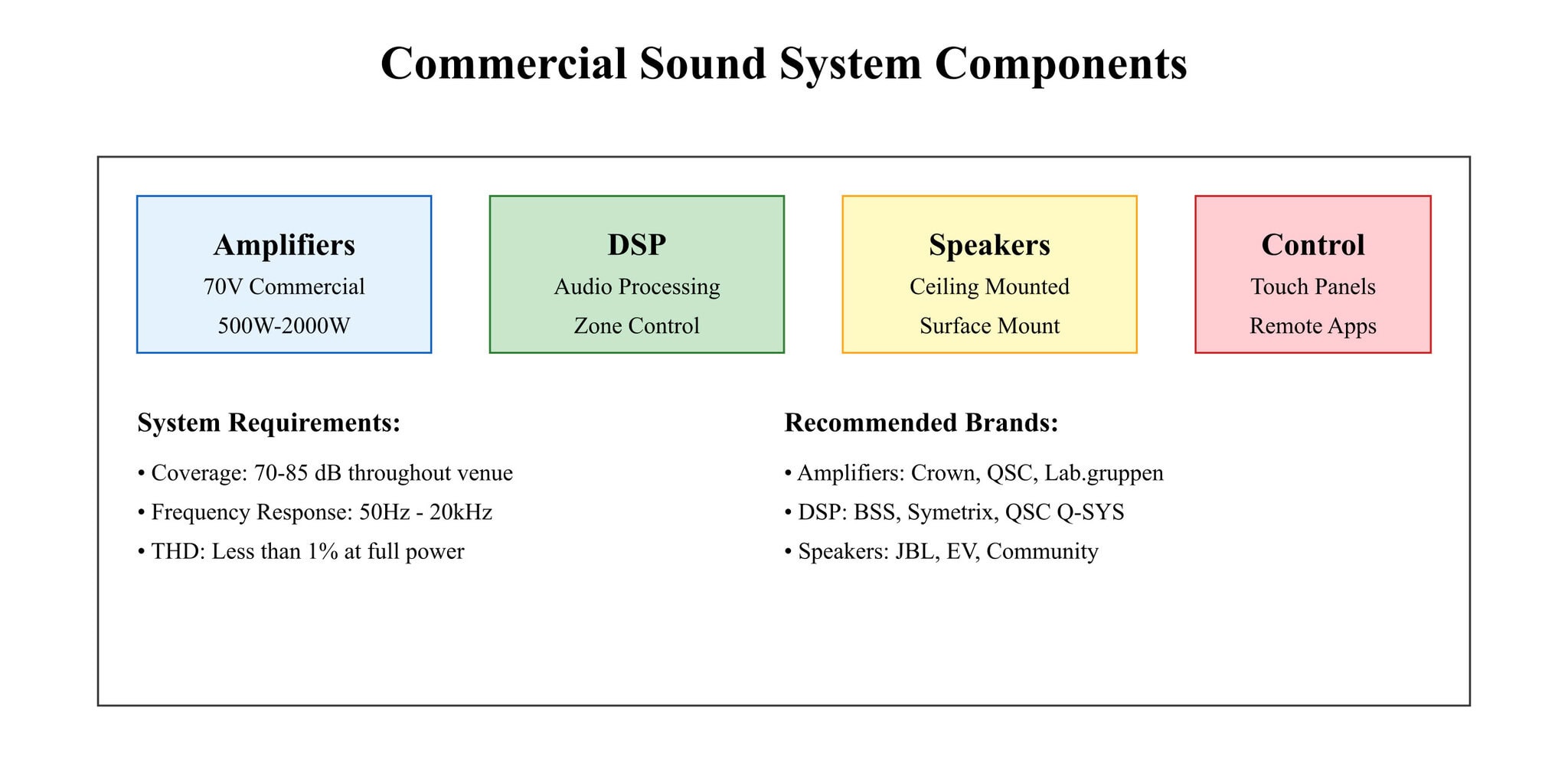
Sound Zoning with Visual Displays
TV Display placement needs to match your sound zoning strategy to establish unified viewing spaces. Independent volume control functions alongside distinct audio routing paths to control multiple games within every area at once.
For featured games the main bar area keeps volume between 75-85 dB whereas dining spaces require lower sound exposures between 65-75 dB for guests to hold conversations without difficulty.
Every private room needs standalone audio control systems and outdoor spaces require speakers that endure weather and produce powerful sound to cut through environmental noises.
| Zone Type | Audio Level (dB) | Content Type | Speaker Layout |
|---|---|---|---|
| Main Bar | 75-85 | Primary Game Audio | Directional Array |
| Dining Area | 65-75 | Background/Secondary | Ceiling Mounted |
| Private Rooms | 70-80 | Dedicated Audio | In-wall/Ceiling |
| Outdoor Patio | 70-80 | Weather-resistant | Surface Mount |
Audio Distribution Methods
Three main audio distribution methods exist for modern sports bars which provide unique benefits.
- Traditional 70V systems provide economical audio distribution across extended distances while allowing straightforward system expansion.
- Dante networks enable flexible digital routing while maintaining minimal latency and they work seamlessly with contemporary control systems.
- AVB technology (Audio Video Bridging) combines precise time synchronization for audio signals with integrated flexible QoS which makes it suitable for extensive commercial applications that need dependable enterprise-level performance.
Venue size together with budget constraints and existing infrastructure integration needs determine the infrastructure.
| Distribution Method | Key Features | Bandwidth | Best For | Typical Cost |
|---|---|---|---|---|
| 70V System | • Long cable runs (up to 1000ft) • Multiple speaker taps • Simple expansion • No network required • Independent volume controls | Analog | • Small/medium venues • Basic installations • Budget-conscious projects | $2-$5K per zone |
| Dante Network | • Digital audio over IP • Ultra-low latency (<1ms) • 1024 channels • Device discovery • Redundancy support | 1Gbps per 512 channels | • Large venues • Complex routing • High-end installations | $5-$15K per system |
| AVB System | • IEEE standard • Time synchronization • QoS guaranteed • Zero configuration • Stream redundancy | 100Mbps per 100 channels | • Enterprise venues • Mission-critical • IT-managed facilities | $8-$20K per system |
| CobraNet | • Legacy support • 64 channels • Fixed latency • Simple setup • Widely compatible | 100Mbps shared | • Legacy systems • Basic digital audio • Existing infrastructure | $3-$8K per system |
| AES67 | • Interoperability standard • Multi-vendor support • PTP synchronization • RAVENNA compatible • Low latency | 1Gbps per 256 channels | • Mixed systems • Broadcast facilities • Hybrid installations | $6-$18K per system |
Volume Control Integration
Effective volume control demands an integrated approach with multiple interface types for system efficiency. Staff can make rapid zone adjustments through wall-mounted controllers while touch panels deliver complete system control and status monitoring capabilities.
Through mobile app integration managers can monitor operations and make remote changes which proves especially beneficial for businesses with multiple locations.
Automated systems manage both scheduled volume changes and event-based adjustments which decreases staff workload while maintaining consistent operation during business hours.
| Control Type | Application | Features | Cost Range |
|---|---|---|---|
| Wall Controls | Zone Volume | • Simple interface • Direct access • No network needed | $100-$300 |
| Touch Panels | System Control | • Full system control • Custom interface • Status monitoring | $800-$2000 |
| Mobile App | Remote Management | • Wireless control • Multiple users • Custom permissions | $500-$1500 |
| Automation | Scheduled Control | • Time-based changes • Event triggers • Integration ready | $1000-$3000 |
AV Control Systems for Sports Bars
Sports bar audiovisual operations depend on AV Control Systems which function as their central nervous system to manage displays and audio zones while distributing content.
AV control systems contribute to efficient operations, they minimize staff workload while delivering a uniform customer experience. Contemporary control platforms combine multiple subsystems including video matrices and audio processors with digital signage into one user-friendly interface.
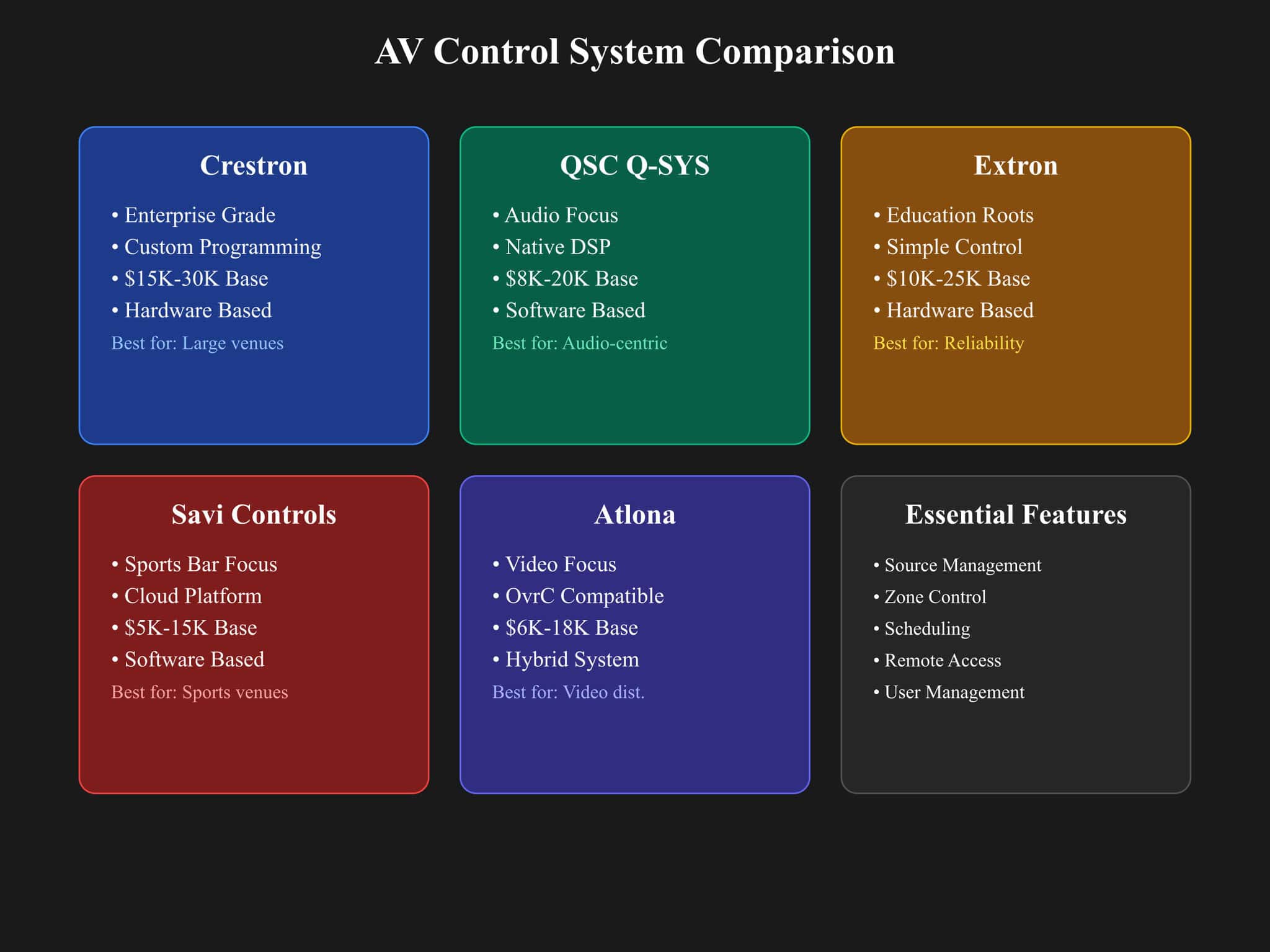
Centralized Management Solutions
A centralized management solution functions as the operational hub for all AV activities in a sports bar. Crestron, RTI and Control4 systems enable unified management of displays and audio zones along with content distribution through user-friendly touch interfaces.
These platforms connect to different AV components through IP, RS-232 and IR control protocols to allow multiple subsystems to operate together through one interface.
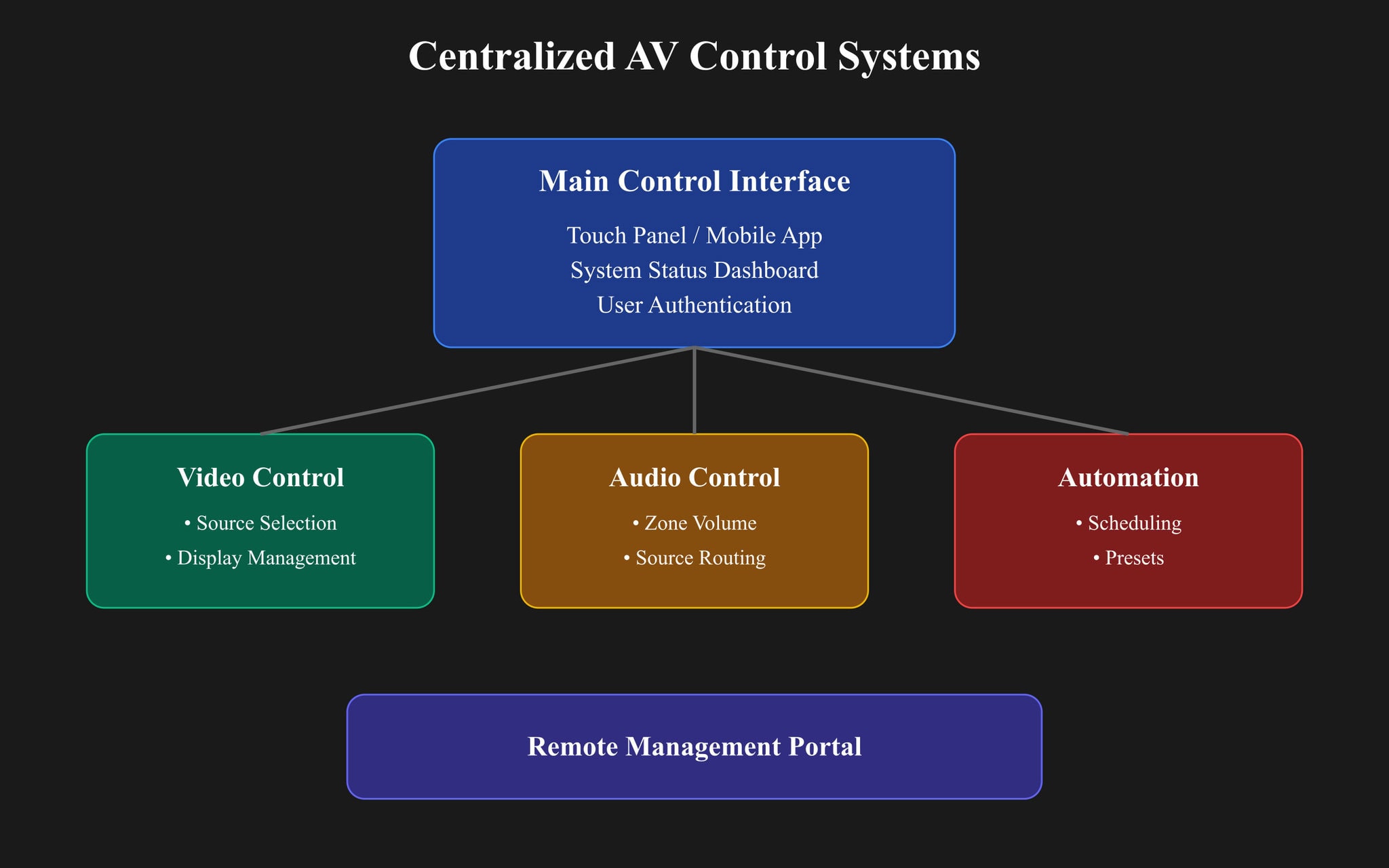
Staff Training Considerations
AV control systems staff training needs a structured multi-level approach which supports various user roles and responsibilities. Basic operations training teaches front-line staff how to perform daily tasks and basic troubleshooting during a 2-4 hour session.
The advanced user training program covers system management and event setup while requiring 8-16 hours of instruction for shift leads and managers. Administrator training requires technical managers and key personnel to learn comprehensive system control and configuration along with advanced troubleshooting techniques in a 16-24 hour program.
Annual training updates need to be combined with quick reference guides and emergency procedures displayed at control points. Documentation needs to deliver instructional steps with visual representations together with explanations for solving common problems and technical support contact details.
Automated Scheduling
Automation of scheduling enhances daily operations because it directs standard tasks to operate independently from staff involvement. Business hours and event schedules allow systems to control display power states and audio levels while switching content automatically.
Sports calendar integration allows automatic game day settings while preset scenes activate during specific day-parts to maintain consistent operation and lessen staff responsibilities.
Remote Management Capabilities
Control and monitoring of systems happens from any location through remote management functions. Secure web portals paired with mobile apps allow managers to control system operations remotely by offering access to system monitoring functionality as well as settings adjustment and troubleshooting actions.
Multi-location operations benefit from this functionality as well as situations requiring immediate response during non-business hours. Advanced systems deliver comprehensive analytics together with automated alerts to ensure systems operate at their best.
Maintenance and Support
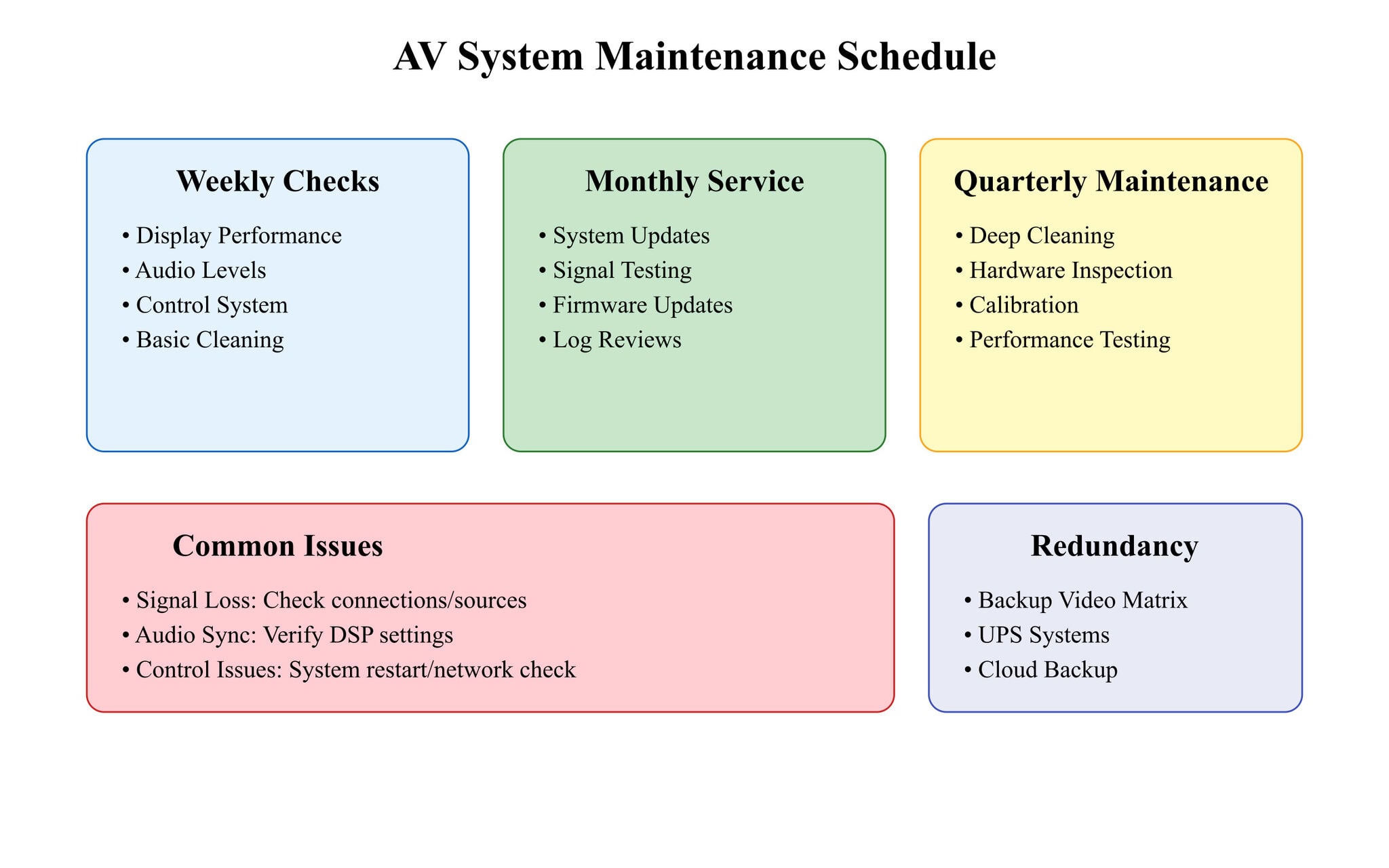
Preventive Maintenance Schedules
System reliability relies on a consistent maintenance program. On a weekly basis technical operations receive inspection followed by monthly services adding updates with testing protocols then quarterly maintenance tasks include deep cleaning with additional calibration steps.
The schedule for hardware inspections and performance validations depends on how equipment is used and the surrounding environmental conditions.
Common Issues and Solutions
Most AV system issues fall into three categories: AV system issues typically involve signal problems with HDMI connections and source devices as well as audio synchronization challenges related to DSP settings and network timing together with control system responsiveness which depends on network connectivity and software stability.
By utilizing quick-resolution protocols together with troubleshooting guides organizations can achieve decreased system downtime.
Backup Systems Implementation
Consistent operational performance remains secure with robust backup system implementation against hardware failures and system problems. A complete backup strategy includes UPS systems designed for essential components with 30-60 minutes runtime capabilities together with redundant video matrix switches for immediate failover and daily updates to cloud-based configuration backups.
Content sources that operate at critical levels should keep extra devices available for immediate use and redundant network paths with automatic fail-over techniques minimize downtime in cases of disconnection. High-traffic venues benefit from reduced downtime through the maintenance of on-site spare parts inventories which include displays, control processors and audio amplifiers.
The backup documentation comprising recovery steps and configuration files delivers rapid system recovery capabilities to staff and AV support personnel.
Future-Proofing Your Sports Bar TV Setup
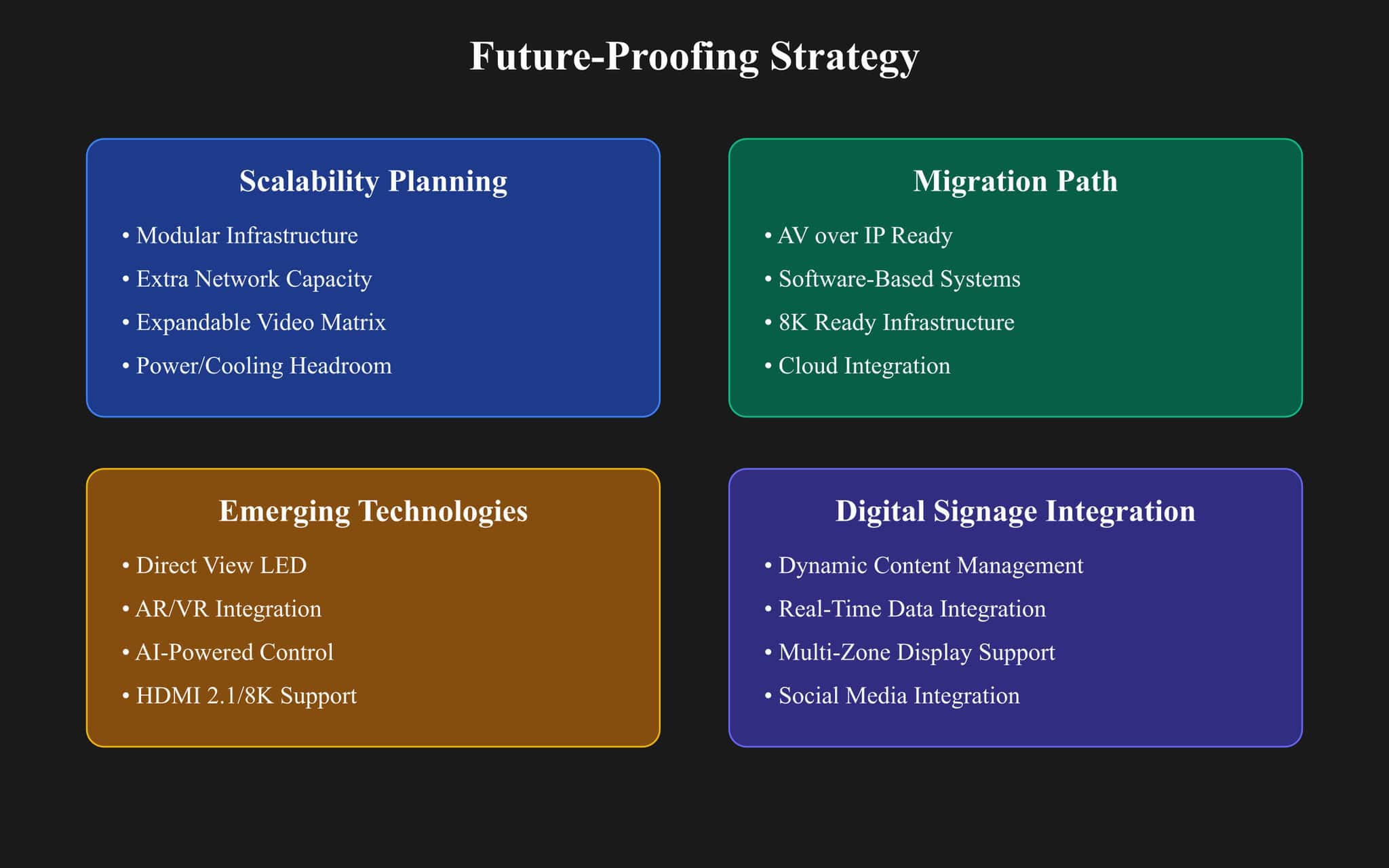
Scalability Planning
On the AV System design phase, include 25-30% extra capacity for power requirements as well as cooling and network bandwidth to support future expansion. The structure of infrastructure planning builds around adaptable parts and unified standards to allow new technology components to integrate smoothly.
Network infrastructure requires a minimum support of 10Gb bandwidth alongside established pathways for upgrading system bandwidth in response to development requirements.
Technology Migration Paths
The migration strategy utilizes software-defined systems together with AV over IP architecture. Current systems need network infrastructure that supports 8K video transport while providing cloud-based management capabilities and format-agnostic distribution methods.
Universal control protocols maintain operational compatibility with future technologies which safeguards current investments.
Emerging Display Technologies
The display technology arena progresses as direct view LED walls develop sub-1mm pixel pitch abilities and 8K resolution strength in combination with improved HDR functionality.
Sports bar environments now require interactive display systems and extended reality (XR) integration as standard features. The system infrastructure needs to provide support for advancing technologies by using flexible architecture together with standardized interfaces.
Integration with Digital Signage
Current generation AV platforms facilitate digital signage operations with the help of integrated content management solutions. The system supports live sports metrics alongside automated menu displays and evolving advertisements without sacrificing performance stability.
By combining social media connections with live data streams businesses can boost their customer interaction levels but maintain unchanged primary AV system operations.
Transform Your Sports Bar
Crunchy Tech’s professional AV solutions will transform your sports bar into a top entertainment destination. Our 15-year track record in 72 cities enables us to provide tailored systems which improve customer satisfaction and increase revenue.